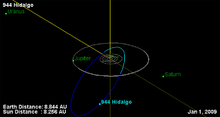944 Hidalgo
| Discovery [1] | |
|---|---|
| Discovered by | W. Baade |
| Discovery site | Bergedorf Obs. |
| Discovery date | 31 October 1920 |
| Designations | |
| MPC designation | (944) Hidalgo |
| Pronunciation | /hɪˈdælɡoʊ/ hi-DAL-goh |
Named after |
Miguel Hidalgo y Costilla (Mexican revolutionary)[2] |
| 1920 HZ | |
|
centaur [1] · main-belt [3] distant Jupiter-crosser Saturn-crosser | |
| Orbital characteristics [1] | |
| Epoch 4 September 2017 (JD 2458000.5) | |
| Uncertainty parameter 0 | |
| Observation arc | 96.59 yr (35,278 days) |
| Aphelion | 9.5366 AU |
| Perihelion | 1.9470 AU |
| 5.7418 AU | |
| Eccentricity | 0.6609 |
| 13.76 yr (5,025 days) | |
| 330.09° | |
| 0° 4m 17.76s / day | |
| Inclination | 42.524° |
| 21.422° | |
| 56.682° | |
| Jupiter MOID | 0.3286 AU |
| Physical characteristics | |
| Dimensions |
38 km (Gehrels)[1] 44.62 km (derived)[4] 52.45±3.60 km[5] 61.4±12.7 km[6] |
| 10.063±0.0003 h[4] | |
|
0.057 (estimate)[4] 0.06 (unverified)[1] | |
| Tholen = D [1][4] | |
| 10.48[4] · 10.77[1] | |
|
| |
944 Hidalgo (/hɪˈdælɡoʊ/ hi-DAL-goh) is a dark and eccentric minor planet from the outer Solar System, approximately 50 kilometers in diameter. Discovered by German astronomer Walter Baade in 1920, it is the first member of the centaurs – a dynamical population with semi-major axis between those of Jupiter and Saturn – ever to be discovered. It was named after Mexican revolutionary Miguel Hidalgo y Costilla.[2]
Discovery and subsequent studies

Hidalgo was discovered by German astronomer Walter Baade on 31 October 1920 at Bergedorf Observatory in Hamburg, Germany.[3] It is named for Miguel Hidalgo y Costilla, who was responsible for declaring Mexico's independence in 1810 and the ensuing Mexican War of Independence. German astronomers who were in Mexico to observe a total eclipse on 10 September 1923 had an audience with President Álvaro Obregón. During this meeting, they asked his permission to name the asteroid after Hidalgo.[2]
It was one of five minor planets included in the 1993 study, Transition Comets—UV Search for OH Emissions in Asteroids, which was research involving amateur astronomers who were permitted to make use of the Hubble Space Telescope.
In the late 1990s, a network of astronomers worldwide gathered light curve data that was ultimately used to derive the spin states and shape models of 10 new asteroids, including Hidalgo. The authors describe the shape model as having 'very large flat areas and a "rectangular" pole-on silhouette, which are strong indications of a highly nonconvex shape'. Some of the light curves show sharp minima, which indicates the object shape may have two lobes.[7] Lightcurve data has also been recorded by observers at the Antelope Hills Observatory, which has been designated as an official observatory by the Minor Planet Center.[8]
When Pluto was discovered Hidalgo was the furthest known minor planet from the Sun.[9]
Orbit
Hidalgo is a centaur because it has a semi-major axis between Jupiter's and Neptune's,[1] while the Minor Planet Center simply classifies it as an asteroid of the main belt.[3] Hidalgo has traditionally been considered an asteroid because centaurs were not recognized as a distinct class until the discovery of 2060 Chiron in 1977. The term cis-Neptunian object and distant object, a more generic term that also includes objects further out the Solar System such as trans-Neptunian objects – are also used.
With a high eccentricity of 0.66, its perihelion of 1.95 AU takes it to the inner edge of the asteroid belt, whereas its aphelion of 9.54 AU takes it out to Saturn's orbit, a characteristic normally associated with Saturn's family of comets. Some astronomers therefore suspect that it was once a comet. Strictly speaking, Hidalgo is a Saturn-grazer rather than a Saturn-crosser as its aphelion does not clear Saturn's. Hidalgo's severe orbital inclination of 43° is suspected to be the result of a close encounter with Jupiter. Even as recently as 1922, Hidalgo passed within 0.89 AU of Jupiter.[10] The orbit of Hidalgo has a Jupiter Minimum orbit intersection distance (MOID) of only 0.33 AU (49,000,000 km; 31,000,000 mi).[1]
References
- 1 2 3 4 5 6 7 8 9 "JPL Small-Body Database Browser: 944 Hidalgo (1920 HZ)" (2017-06-02 last obs.). Jet Propulsion Laboratory. Retrieved 12 October 2017.
- 1 2 3 Schmadel, Lutz D. (2007). Dictionary of Minor Planet Names – (944) Hidalgo. Springer Berlin Heidelberg. p. 83. ISBN 978-3-540-00238-3. Retrieved 12 October 2017.
- 1 2 3 "944 Hidalgo (1920 HZ)". Minor Planet Center. Retrieved 12 October 2017.
- 1 2 3 4 5 "LCDB Data for (944) Hidalgo". Asteroid Lightcurve Database (LCDB). Retrieved 12 October 2017.
- ↑ Usui, Fumihiko; Kuroda, Daisuke; Müller, Thomas G.; Hasegawa, Sunao; Ishiguro, Masateru; Ootsubo, Takafumi; et al. (October 2011). "Asteroid Catalog Using Akari: AKARI/IRC Mid-Infrared Asteroid Survey". Publications of the Astronomical Society of Japan. 63 (5): 1117–1138. Bibcode:2011PASJ...63.1117U. doi:10.1093/pasj/63.5.1117. Retrieved 12 October 2017.
- ↑ Licandro, J.; Alí-Lagoa, V.; Tancredi, G.; Fernández, Y. (January 2016). "Size and albedo distributions of asteroids in cometary orbits using WISE data". Astronomy and Astrophysics. 585: 12. arXiv:1510.02282. Bibcode:2016A&A...585A...9L. doi:10.1051/0004-6361/201526866. Retrieved 12 October 2017.
- ↑ Durech, J.; et al. (April 2007), "Physical models of ten asteroids from an observers' collaboration network", Astronomy and Astrophysics, 465 (1), pp. 331–337, Bibcode:2007A&A...465..331D, doi:10.1051/0004-6361:20066347.
- ↑ http://www.antelopehillsobservatory.org/Lightcurves/944.gif
- ↑ "JPL Small-Body Database Search Engine". JPL Solar System Dynamics. Archived from the original on 31 May 2008. Retrieved 2008-05-27. (characteristic:a>5.7)
- ↑ "JPL Close-Approach Data: 944 Hidalgo (1920 HZ)" (2008-06-10 last obs). Retrieved 2009-05-05.
External links
- Lightcurve plot of (944) Hidalgo, Antelope Hills Observatory
- Asteroid Lightcurve Database (LCDB), query form (info)
- Dictionary of Minor Planet Names, Google books
- Discovery Circumstances: Numbered Minor Planets (1)-(5000) – Minor Planet Center
- 944 Hidalgo at the JPL Small-Body Database
